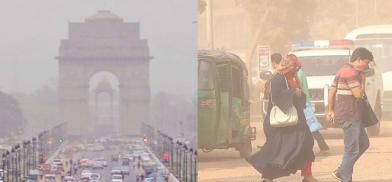Bangladesh, India need to combat air pollution without compromising economic growth
Both the governments of Bangladesh and India can come out with policies that promote renewable energy sources, which will help to improve air quality and human health, writes Safen Roy for South Asia Monitor

Face masks will be a legacy of the COVID-19 pandemic for years to come. Although there has been a fierce debate whether face mask reduces a viral contagion, there is enough evidence to show that they indeed help capture PM (particulate matter) 2.5.
With both India and Bangladesh's capital cities - Delhi and Dhaka - topping the AQI index almost every other day, air pollution should be the utmost concern of these two countries. According to IQAir, a Swiss-based air quality technology company that collects air quality globally, New Delhi was the second-most polluted capital city for the second consecutive year in 2019. According to this report, New Delhi's annual average PM2.5 concentration in a cubic meter of air was 98.6. New Delhi's pollution is caused by cars and factory pollutants, construction dust, waste smoke, and crop residues.
In 2019, Dhaka stood up with a PM2.5 reading of 83.3 ugs per cubic metre, bringing it into the 'unhealthy' air quality bracket.
Air pollution a health hazard
We all know that air pollution, which is a serious public and environmental hazard, causes long-term health effects, including heart disease, lung cancer, and respiratory diseases, but we don’t care about all these problems as we channel our resources to developing our nations. To increase economic growth, we don’t mind living under hazy skies, coughing up dust that results in more health problems.
In February 2018, researchers found that 9 out of 10 people on earth breathe air that does not meet World Health Organisation (WHO) air quality guidelines. The Asian region's air pollution burden is among the highest on the globe. About 2.4 million premature deaths in 2016 were caused by air pollution.
According to a 2019 Climate and Clean Air Coalition (CCAC) and United Nations Environment Programme (UNEP) report, which presented the first-ever scientific assessment of air pollution across 23 countries in the region, about 92 percent of the population - about 4 billion people - in the Asia Pacific region is exposed to levels of air pollution that pose a significant risk to their health. It said that air pollution not only poses a major health risk, it also has damaging impacts on the environment and agricultural crop yields. These impacts have significant economic consequences, affecting economic growth as well as welfare.
Air pollution impacting agricultural production
Air pollution effect the productivity of agricultural production and food security in the countries of the region. For Bangladesh, it is not good news. More than 70 percent of the population of Bangladesh lives in its villages. More than 70 percent of Bangladesh’s population and 77 percent of its workforce lives in rural areas.
Nearly half of all of Bangladesh’s workers and two-thirds in rural areas are directly employed by agriculture, and about 87 percent of rural households rely on agriculture for at least part of their income. Agriculture is a major economic activity in Bangladesh, and contributes around 20 percent of the country's GDP. Growth in the agricultural sector has important linkages with the overall economy through various channels. Air pollution can thus have a serious impact on agricultural crop yield.
It is known fact that Dhaka’s air is contaminated with heavy metals and other poisonous particles. But experts feel that if the government takes some initiatives to manage air pollution then it can be managed. The government should continue to collect data on air quality, identify polluting sources and then accordingly take apt measures to try to improve the air quality of the city. In Bangladesh, the dominant polluting sources are transportation, dust from construction, and the burning of materials as done in brick kilns.
Are Dhaka and Delhi doing enough?
But the question is whether the measures being taken by the governments of Bangladesh and India pragmatic enough? In the ideal situation, one has to rely on urban planning and central government politics to fight air pollution. But, if the people have to survive on air purifiers and even face masks then it surely indicates that the people of these two countries are very poorly equipped to battle this problem.
Both the governments of Bangladesh and India can come out with policies that promote renewable energy sources, which will help to improve air quality and human health. The governments could also provide better electric vehicles subsidies and then see to it that their initiatives are able to limit Volatile Organic Compounds (VOCs') emissions from factories. VOC emissions are said to lead to negative respiratory, allergic, or immune effects such as eye, nose, and throat irritation, headaches, loss of coordination, and nausea. They can also damage the liver, kidneys, and central nervous system, and also suspected to cause cancer.
Moreover, the governments should put a limit on the number of diesel-operated cars in Dhaka and Delhi roads. Also, state-owned enterprises should update their facilities to mitigate carbon emissions and update their buildings. Lastly, power plants should install equipment to extract nitrogen from the air. This will help in improving the air quality.
Thus to reduce air pollution, the governments of the two countries must act. They should also rope in people when they take the initiatives to combat air pollution. They should ensure that policies and initiatives to tackle air pollution are in place, while simultaneously keeping in mind that these measures don’t deter economic growth.
(The writer studies at the Graduate School of Chulalongkorn University, Bangkok, Thailand. The views are personal. He can be contacted at safenroy@gmail.com)
Volleyball.









Post a Comment